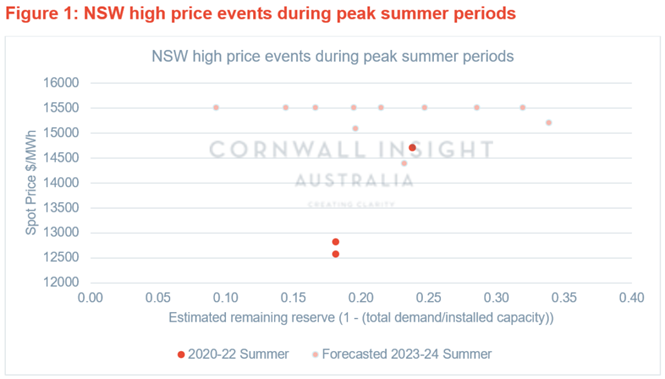According to findings by Cornwall Insight Australia, this week’s closure of Liddell Power Station is expected to drive up average power prices during peak periods in New South Wales (NSW). Prices, particularly in the summer1, are expected to be higher compared to the previous three years.
As demand peaks during summer afternoons and solar generation wanes in the evenings, NSW’s slow build-out of batteries could hinder the ability of solar power to contribute during these high-demand periods. The lack of energy storage solutions could compound the peak-time fallout from Liddell’s closure, leaving the state vulnerable to costly supply constraints.
While peak time shortages are a concern, the power station’s closure is expected to have a relatively modest overall impact during non-peak periods, with the seven-year lead-in time allowing the market to respond proactively with further build-out of renewables as well as the new Tallawarra B Project. While we do anticipate a rise in prices during peak periods, Cornwall Insight’s Benchmark Power Curve predicts a lower median price
In addition, the generating capacity of Liddell Power Station has significantly declined in recent years, dropping from 2,000MW to 800MW due to the earlier closure of LD03 and underutilisation of the remaining three turbines. As a result, the impact of the closure may not be as severe during non-peak times as initially anticipated.

Source: Cornwall Insight
Cornwall Insight's Benchmark Power Curve (BPC) forecasts NSW's upcoming summer to have a lower median price than the previous three years. However, as Figure 1 shows, it is much more likely for the spot price to reach $12,000/MWh during this upcoming summer than the previous years. While very high peak prices are still quite rare, these occurrences skew the distribution resulting in a forecasted higher average price this summer.
Corey Drum, Energy Market Specialist at Cornwall Insight Australia, said:
“The anticipated rise in peak-time power prices following the closure of Liddell power station underscores the need for investment in effective battery storage systems. Deploying these systems in NSW could help mitigate the impact of high prices and complement existing solar resources, enabling users to take advantage of high evening prices or generate revenue through energy arbitrage.
“While easing the fallout from the closure of Liddell should be a priority for NSW, we must keep the impact in perspective. Unlike previous power station closures such as Hazelwood, NSW has had time to prepare for the loss of generation capacity and has responded with the expansion of other energy projects. The contribution of Liddell has also been overestimated, meaning the closure could be less damaging than it first appears.
“As we wait to see the effects the closure will have on power prices, one thing is for sure, NSW must stay vigilant and committed to supporting the continued expansion of renewable energy and energy storage solutions. We believe that these measures will not only help stabilise the grid but also lead to more sustainable, affordable energy for consumers in the long-term.”